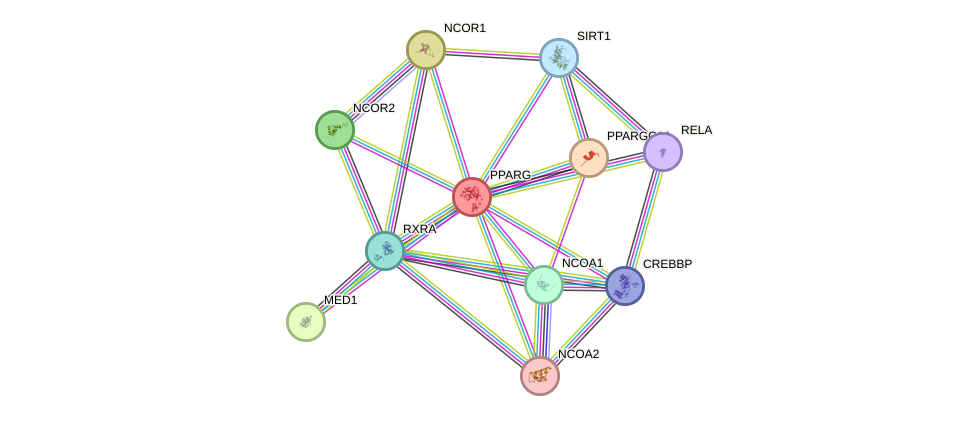GenAge entry for PPARG (Homo sapiens)
Gene name (HAGRID: 263)
- HGNC symbol
- PPARG
- Aliases
- PPARG1; PPARG2; NR1C3; PPARgamma
- Common name
- peroxisome proliferator-activated receptor gamma
Potential relevance to the human ageing process
- Main reason for selection
- Entry selected based on evidence linking the gene product to a pathway or mechanism linked to ageing
- Description
Peroxisome proliferator-activated receptor (PPAR)gamma-2 is an important regulator of adipose tissue metabolism, insulin sensitivity and inflammatory response. Recent studies have identified klotho (KL) as a target gene for peroxisome proliferator-activated receptor-gamma (PPARg) [2141]. Mutant mice with a lowered expression of Pparg had a reduced lifespan compared to wild type [2142], however adipose tissue-specific PPARg heterozygous mice exhibited significant improvement in insulin sensitivity in skeletal muscle and showed an increased resistance to paraquat-induced oxidative stress [3665]. The level of PPARs (including PPARG) is reduced with age and caloric restriction in mice appears to prevent these alteration, suggesting common mechanisms [2143].
Mutations in PPARG may be one of the causes of type 2 insulin-resistant diabetes and hyptertension [2144] and a polymorphism of PPARG has been associated to early atherosclerosis [2145]. Defects in PPARG may also be associated with colon cancer [2146]. Genome-wide association studies have identified a paraoxonase Pro/Ala gene polyporphism which is associated to human longevity [2147].
Cytogenetic information
- Cytogenetic band
- 3p25
- Location
- 12,287,850 bp to 12,434,356 bp
- Orientation
- Plus strand
Protein information
- Gene Ontology
-
Process: GO:0000122; negative regulation of transcription from RNA polymerase II promoter
GO:0001890; placenta development
GO:0002674; negative regulation of acute inflammatory response
GO:0006367; transcription initiation from RNA polymerase II promoter
GO:0006629; lipid metabolic process
GO:0006919; activation of cysteine-type endopeptidase activity involved in apoptotic process
GO:0007165; signal transduction
GO:0007186; G-protein coupled receptor signaling pathway
GO:0007507; heart development
GO:0007584; response to nutrient
GO:0008217; regulation of blood pressure
GO:0009409; response to cold
GO:0009612; response to mechanical stimulus
GO:0010742; macrophage derived foam cell differentiation
GO:0010745; negative regulation of macrophage derived foam cell differentiation
GO:0010871; negative regulation of receptor biosynthetic process
GO:0010887; negative regulation of cholesterol storage
GO:0010891; negative regulation of sequestering of triglyceride
GO:0015909; long-chain fatty acid transport
GO:0019395; fatty acid oxidation
GO:0030224; monocyte differentiation
GO:0030308; negative regulation of cell growth
GO:0030855; epithelial cell differentiation
GO:0031000; response to caffeine
GO:0031100; animal organ regeneration
GO:0032526; response to retinoic acid
GO:0032869; cellular response to insulin stimulus
GO:0032966; negative regulation of collagen biosynthetic process
GO:0033189; response to vitamin A
GO:0033993; response to lipid
GO:0035357; peroxisome proliferator activated receptor signaling pathway
GO:0035902; response to immobilization stress
GO:0042493; response to drug
GO:0042593; glucose homeostasis
GO:0042594; response to starvation
GO:0042752; regulation of circadian rhythm
GO:0042953; lipoprotein transport
GO:0043401; steroid hormone mediated signaling pathway
GO:0043627; response to estrogen
GO:0045087; innate immune response
GO:0045165; cell fate commitment
GO:0045600; positive regulation of fat cell differentiation
GO:0045713; low-density lipoprotein particle receptor biosynthetic process
GO:0045892; negative regulation of transcription, DNA-templated
GO:0045893; positive regulation of transcription, DNA-templated
GO:0045944; positive regulation of transcription from RNA polymerase II promoter
GO:0046321; positive regulation of fatty acid oxidation
GO:0048469; cell maturation
GO:0048511; rhythmic process
GO:0048662; negative regulation of smooth muscle cell proliferation
GO:0048714; positive regulation of oligodendrocyte differentiation
GO:0050872; white fat cell differentiation
GO:0051091; positive regulation of sequence-specific DNA binding transcription factor activity
GO:0051974; negative regulation of telomerase activity
GO:0055088; lipid homeostasis
GO:0055098; response to low-density lipoprotein particle
GO:0060100; positive regulation of phagocytosis, engulfment
GO:0060336; negative regulation of interferon-gamma-mediated signaling pathway
GO:0060694; regulation of cholesterol transporter activity
GO:0060850; regulation of transcription involved in cell fate commitment
GO:0071300; cellular response to retinoic acid
GO:0071306; cellular response to vitamin E
GO:0071380; cellular response to prostaglandin E stimulus
GO:0071455; cellular response to hyperoxia
GO:1901558; response to metformin
GO:2000230; negative regulation of pancreatic stellate cell proliferation
Cellular component: GO:0005634; nucleus
GO:0005654; nucleoplasm
GO:0005794; Golgi apparatus
GO:0005829; cytosol
GO:0043231; intracellular membrane-bounded organelle
GO:0048471; perinuclear region of cytoplasm
GO:0090575; RNA polymerase II transcription factor complex
Hide GO termsFunction: GO:0001046; core promoter sequence-specific DNA binding
GO:0003677; DNA binding
GO:0003682; chromatin binding
GO:0003700; transcription factor activity, sequence-specific DNA binding
GO:0003707; steroid hormone receptor activity
GO:0004879; RNA polymerase II transcription factor activity, ligand-activated sequence-specific DNA binding
GO:0004955; prostaglandin receptor activity
GO:0005515; protein binding
GO:0008134; transcription factor binding
GO:0008144; drug binding
GO:0008270; zinc ion binding
GO:0019899; enzyme binding
GO:0019903; protein phosphatase binding
GO:0030331; estrogen receptor binding
GO:0030374; ligand-dependent nuclear receptor transcription coactivator activity
GO:0033613; activating transcription factor binding
GO:0042802; identical protein binding
GO:0043565; sequence-specific DNA binding
GO:0044212; transcription regulatory region DNA binding
GO:0046965; retinoid X receptor binding
GO:0050544; arachidonic acid binding
GO:0051393; alpha-actinin binding
Protein interactions and network
- Protein-protein interacting partners in GenAge
- POU1F1, STAT5A, HDAC3, EGFR, NCOR1, JUND, PIN1, CREBBP, IGFBP3, NR3C1, NFKB1, UBE2I, CEBPB, EP300, PML, PRKCA, XRCC5, XRCC6, RB1, APP, RELA, HDAC1, SP1, JUN, MED1, TFAP2A, MDM2, CTNNB1, PPARGC1A, PPARG, NCOR2, IKBKB
- STRING interaction network
Retrieve sequences for PPARG
Homologs in model organisms
In other databases
- GenAge model organism genes
- A homolog of this gene for Mus musculus is present as Pparg
- LongevityMap
- This gene is present as PPARG
- CellAge
- This gene is present as PPARG

